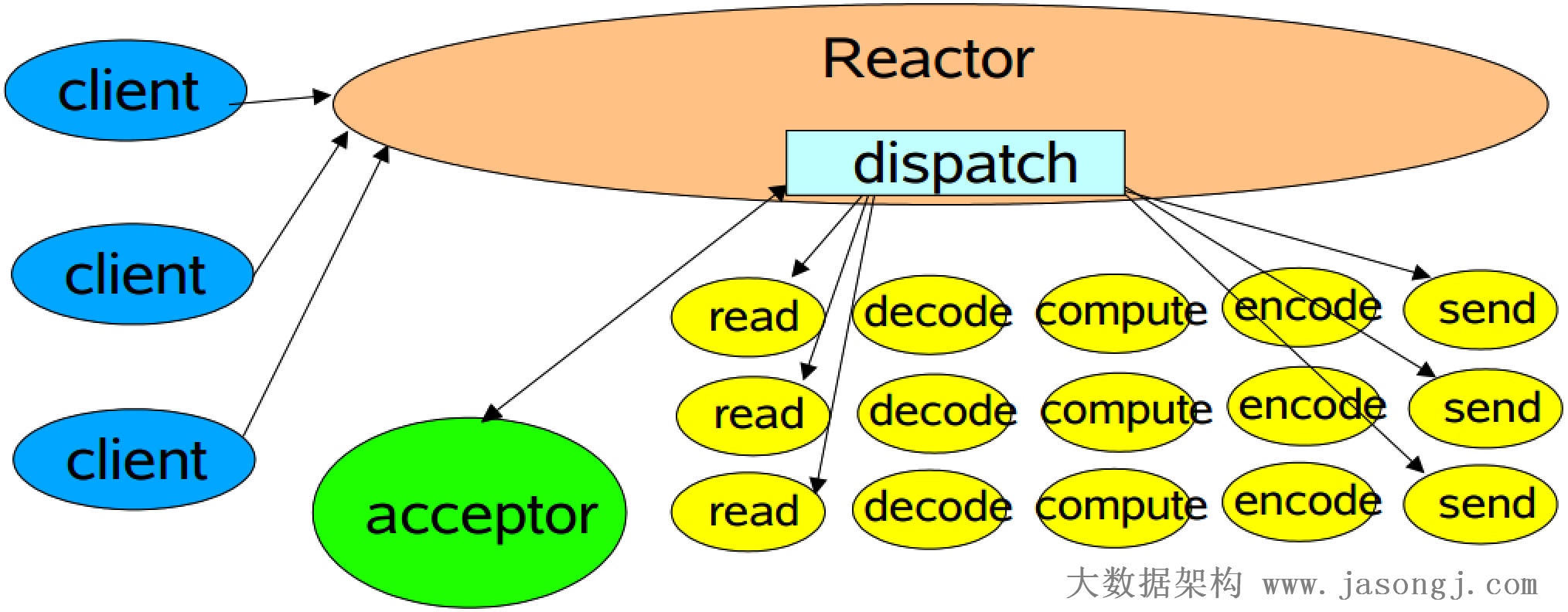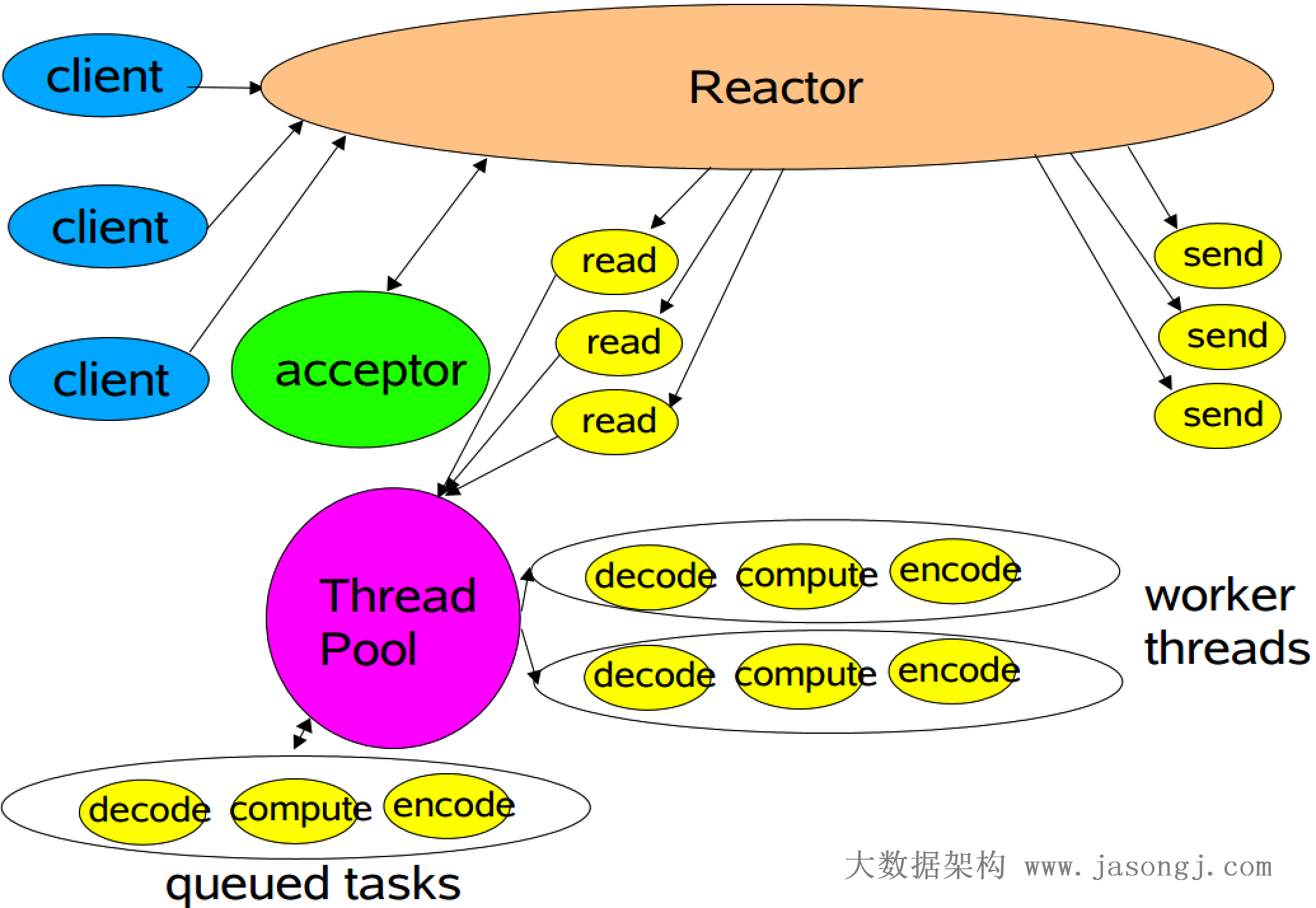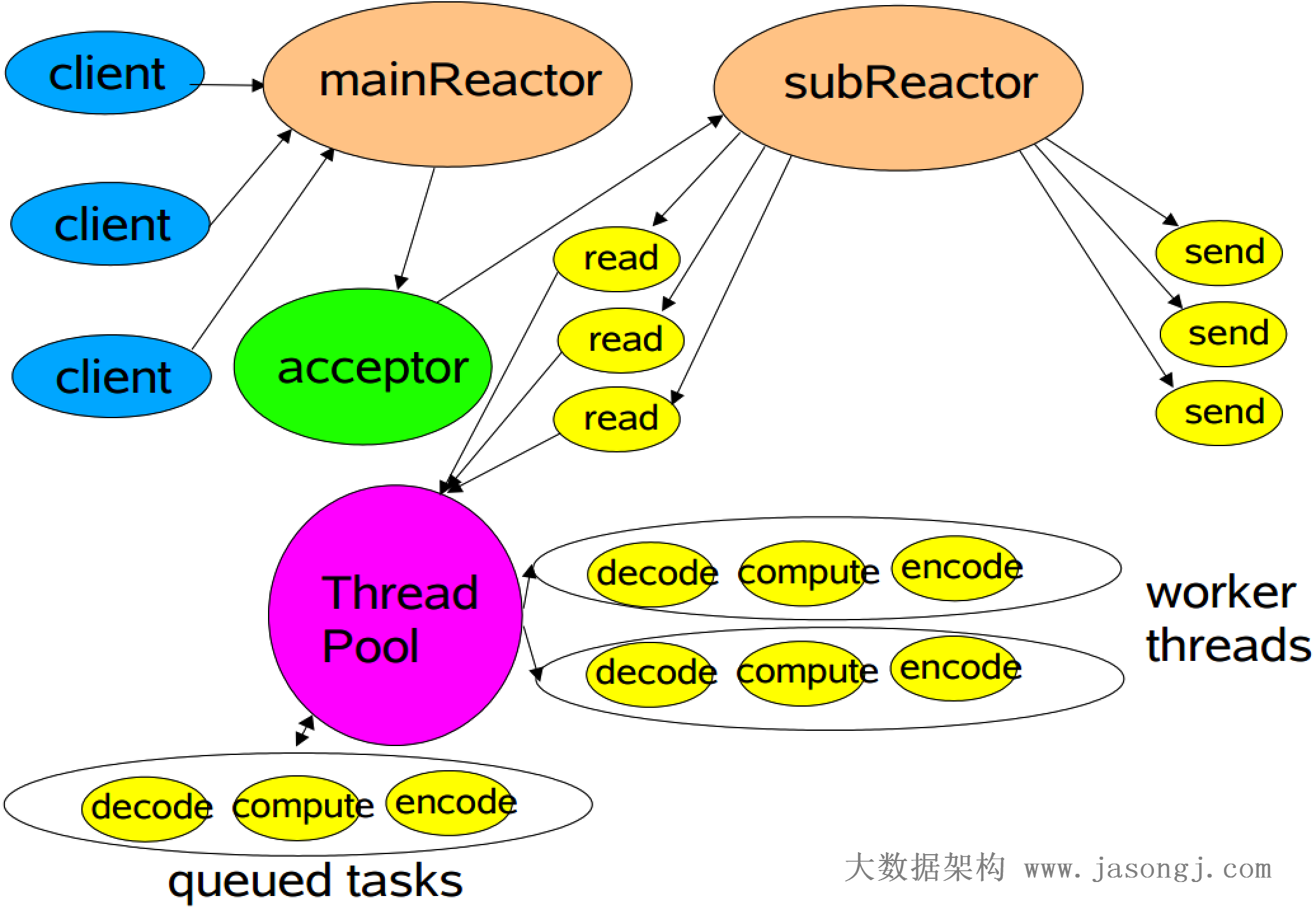nio by javadoop
多路复用 IO 的三大组件
Buffer
和数组差不多,它有 position、limit、capacity 几个重要属性。put() 一下数据、flip() 切换到读模式、然后用 get() 获取数据、clear() 一下清空数据、重新回到 put() 写入数据。
Channel
基本上只和 Buffer 打交道,最重要的接口就是 channel.read(buffer) 和 channel.write(buffer)。
ServerSocketChannel 不和 Buffer 打交道了,因为它并不实际处理数据,它一旦接收到请求后,实例化 SocketChannel,之后在这个连接通道上的数据传递它就不管了,因为它需要继续监听端口,等待下一个连接。
Selector
建立在非阻塞的基础之上,大家经常听到的 多路复用 在 Java 世界中指的就是它。非阻塞 IO 的核心在于使用一个 Selector 来管理多个通道,可以是 SocketChannel,也可以是 ServerSocketChannel,将各个通道注册到 Selector 上,指定监听的事件。
SelectionKey 它包含了 Channel 和 Selector 信息,也包括了一个叫做 Interest Set 的信息,即我们设置的我们感兴趣的正在监听的事件集合。
select() 调用此方法,会将上次 select 之后的准备好的 channel 对应的 SelectionKey 复制到 selected set 中。如果没有任何通道准备好,这个方法会阻塞,直到至少有一个通道准备好。
AsynchronousChannelGroup
异步 IO 一定存在一个线程池,这个线程池负责接收任务、处理 IO 事件、回调等。这个线程池就在 group 内部,group 一旦关闭,那么相应的线程池就会关闭。
netty
使用 Netty 的时候,我们通常就只要写一些自定义的 handler 就可以了。
每个 Channel 内部都有一个 pipeline,pipeline 由多个 handler 组成,handler 之间的顺序是很重要的,因为 IO 事件将按照顺序顺次经过 pipeline 上的 handler,这样每个 handler 可以专注于做一点点小事,由多个 handler 组合来完成一些复杂的逻辑。
在 Netty 中,IO 事件被分为 Inbound 事件和 Outbound 事件。
对于 Inbound 操作,按照添加顺序执行每个 Inbound 类型的 handler;而对于 Outbound 操作,是反着来的,从后往前,顺次执行 Outbound 类型的 handler。
pipeline 中的辅助类 ChannelInitializer,我们看到,它本身是一个 handler(Inbound 类型),但是它的作用和普通 handler 有点不一样,它纯碎是用来辅助将其他的 handler 加入到 pipeline 中的。
在 Netty 中,NioEventLoopGroup 代表线程池,NioEventLoop 就是其中的线程。
线程池 NioEventLoopGroup 是池中的线程 NioEventLoop 的 parent,从上面的代码中的取名可以看出。
每个 NioEventLoop 都有自己的 Selector,上面的代码也反应了这一点,这和 Tomcat 中的 NIO 模型有点区别。
executor、selectStrategy 和 rejectedExecutionHandler 从 NioEventLoopGroup 中一路传到了 NioEventLoop 中。
简单追踪下充当客户端的 Bootstrap 中 NioSocketChannel 的创建过程
Bootstrap.connect() –> doResolveAndConnect() –> initAndRegister()
- channel = channelFactory.newChannel() //Channel 的实例化,实例化过程中,会执行 Channel 内部 Unsafe 和 Pipeline 的实例化
- init(channel) 方法 //会往 pipeline 中添加 handler(pipeline 此时是 head+channelnitializer+tail)
- config().group().register(channel) //开启 NioEventLoop,将 register 操作,提交到 eventLoop
- register0(promise) 非常关键的方法 –doRegister() //进行 JDK 底层的操作:Channel 注册到 Selector 上
- pipeline.invokeHandlerAddedIfNeeded() //将 ChannelInitializer 内部添加的 handlers 添加到 pipeline 中
- pipeline.fireChannelRegistered() //往 pipeline 中扔了一个 channelRegistered 事件
- doResolveAndConnect0() //这一步将连接到服务端
Reactor 模式
转载自:Reactor模式
精典Reactor模式
示意图如下所示。
在Reactor模式中,包含如下角色
- Reactor 将I/O事件发派给对应的Handler
- Acceptor 处理客户端连接请求
- Handlers 执行非阻塞读/写
代码示例与 nio 示例类似。
多线程Reactor模式
经典Reactor模式中,尽管一个线程可同时监控多个请求(Channel),但是所有读/写请求以及对新连接请求的处理都在同一个线程中处理,无法充分利用多CPU的优势,同时读/写操作也会阻塞对新连接请求的处理。因此可以引入多线程,并行处理多个读/写操作,如下图所示。
1 | else if (key.isReadable()) { |
从上示代码中可以看到,注册完SocketChannel的OP_READ事件后,可以对相应的SelectionKey attach一个对象(本例中attach了一个Processor对象,该对象处理读请求),并且在获取到可读事件后,可以取出该对象。
注:attach对象及取出该对象是NIO提供的一种操作,但该操作并非Reactor模式的必要操作,本文使用它,只是为了方便演示NIO的接口。
具体的读请求处理在如下所示的Processor类中。该类中设置了一个静态的线程池处理所有请求。而process方法并不直接处理I/O请求,而是把该I/O操作提交给上述线程池去处理,这样就充分利用了多线程的优势,同时将对新连接的处理和读/写操作的处理放在了不同的线程中,读/写操作不再阻塞对新连接请求的处理。
1 | public class Processor { |
多Reactor模式
Netty中使用的Reactor模式,引入了多Reactor,也即一个主Reactor负责监控所有的连接请求,多个子Reactor负责监控并处理读/写请求,减轻了主Reactor的压力,降低了主Reactor压力太大而造成的延迟。
并且每个子Reactor分别属于一个独立的线程,每个成功连接后的Channel的所有操作由同一个线程处理。这样保证了同一请求的所有状态和上下文在同一个线程中,避免了不必要的上下文切换,同时也方便了监控请求响应状态。
示意图如下所示。
多Reactor示例代码如下所示。
1 | public class NIOServer { |
如上代码所示,本文设置的子Reactor个数是当前机器可用核数的两倍(与Netty默认的子Reactor个数一致)。对于每个成功连接的SocketChannel,通过round robin的方式交给不同的子Reactor。
子Reactor对SocketChannel的处理如下所示。
1 | public class Processor { |
在Processor中,同样创建了一个静态的线程池,且线程池的大小为机器核数的两倍。每个Processor实例均包含一个Selector实例。同时每次获取Processor实例时均提交一个任务到该线程池,并且该任务正常情况下一直循环处理,不会停止。而提交给该Processor的SocketChannel通过在其Selector注册事件,加入到相应的任务中。由此实现了每个子Reactor包含一个Selector对象,并由一个独立的线程处理。